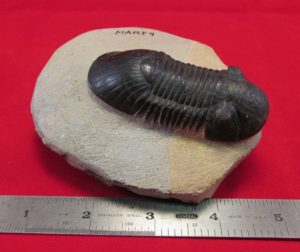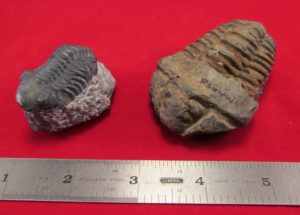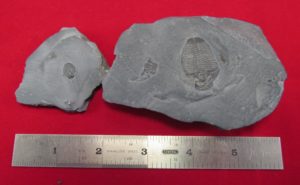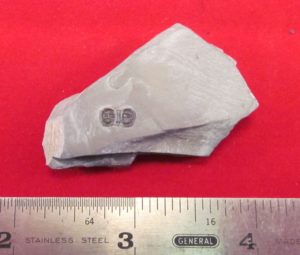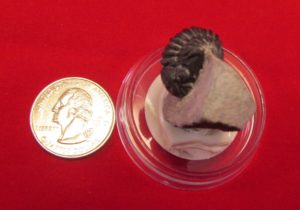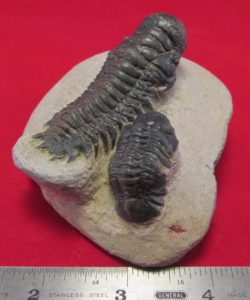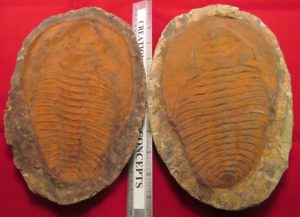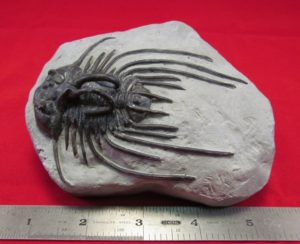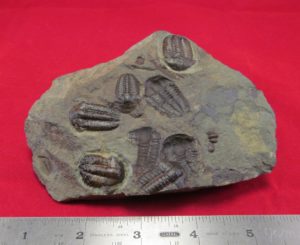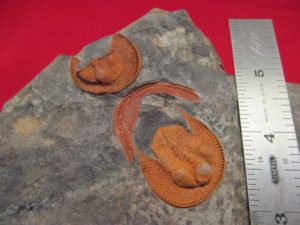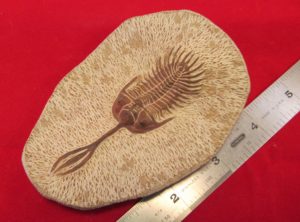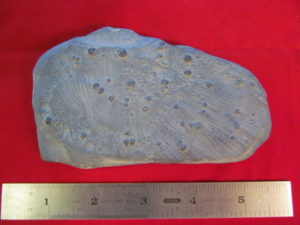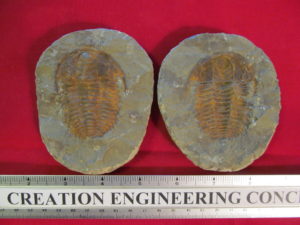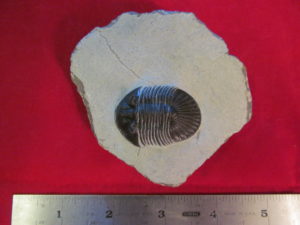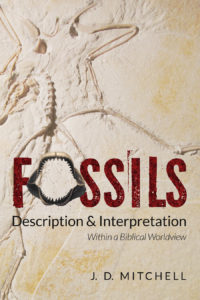All fossil images and descriptions ©2017 all rights reserved. Contact us for permission policy.
Trilobite Paralejuris
Description: The Paralejuris fossil trilobite is 3″ long X 1 1/4″ wide X 9/16″ thick. The matrix is 3 1/2″ wide X 4 1/8″ long X 1″ thick. The head shield is convex and nearly semicircular. There are ten segments of the thorax and the two eyes are positioned at the rear of the glabella (head shield).
Location: Morocco.
Interpretation: Trilobites have three parallel sections or lobes that make up their bodies; and thus the name tri-lobe-ite. These arthropods are found in the rock record by the billions all over the earth. They have many variations and many genus and species names have been assigned to them. They range in size from less than 1/16″ long to over a yard long. They are thought to be extinct and are often described by collectors as “bugs.” Most experts believe that they are most closely related to the horseshoe crab of today.
Paralejuris is a genus among dozens found in Morocco that local entrepreneurs extract, prepare and then sell all over the world. Some of these trilobites are crudely extracted from the rock matrix using a hammer and a nail and others are prepared using the latest paleontological tools and techniques. The particular specimen shown above was prepared with a technique sufficiently advanced to show the complexity of the two eyes and the series of pleural segments along the sides of the animal.
#MARF9
Trilobite Terminology
Trilobite Calymene
Description: The Calymene trilobite in the sandstone matrix (left) is 1 3/4″ long X 7/8″ wide X 1/2″ thick. The matrix is 1 3/4″ long X 1 9/16″ wide X 1/2″ thick. The loose specimen is 3″ long X 3″ wide X 1″ thick. Detail of the smaller specimen allows for seeing hundreds of lenses in the two eyes and the 13 grooved thoracic segments. In the loose specimen only ten of the thoracic segments are visible and the eyes are obliterated.
Location: Both from Morocco.
Interpretation: The design of trilobites with a tough external exoskeleton permits them to be found fossilized in the rock record by the millions. Why trilobites became extinct cannot be known for sure, but they demonstrate God’s marvelous design and the foolishness of evolutionary thought.
Many trilobite genera had compound eyes with hundreds of lenses composed of inorganic, crystalline calcium carbonate (calcite). Unlike most animal eyes that are made of organic tissues that are not preserved as fossils, the lenses of trilobites are often perfectly preserved. It is also significant that some of these trilobite lenses are double lenses to allow sight under water without distortion.
#MARF42, 8
Trilobite Elrathia
Description: The smaller Elrathia trilobite (left) is 3/8″ long X 5/16″ wide in a matrix 2 1/4″ X 2 1/16″ X 5/16″ thick. The larger Elrathia is 1 3/16″ long X 3/4″ wide in a matrix 4″ X 2 1/2″ X 3/4″ thick. It has 17 segments in its thorax and is missing the right-hand portion of its head shield. To the left of the larger trilobite is a portion of the front end of another Elrathia trilobite. The small eyes of the trilobites are not discernible in these specimens.
Location: Wheeler Shale in Millard County, Utah.
Interpretation: There are so many of these particular Elrathia trilobites found in the shale rocks of Millard County, Utah that this genus has been designated the state fossil of Utah. Mass mortality plates with many trilobites together in a “graveyard” are quite common, and is a strong indication of the actions of the Genesis Flood that buried and allowed for the fossilization of these fascinating animals.
#MARF44, 47
Trilobite Acadagnostus
Description: Acadagnostus trilobite is only 5/16″ long X 1/8″ wide in a matrix 1 3/4″ X 1 1/8″ X 3/8″ thick.
Location: Wheeler Shale in Millard County, Utah.
Interpretation: The Acadagnostus trilobites are called “blind” trilobites because there are no indications they have eyes. In Utah they are often found in the same shale sediments as Elrathia and are usually very small like the one above.
#MARF48
Trilobite Phacops
Description: The Phacops trilobite is 3/4″ wide X 9/16″ thick X 1 3/16″ long. It has 12 grooved thoracic segments. The specimen matrix is 1″ X 13/16″ X 1 5/8″ long.
Location: Morocco.
Interpretation: The Phacops genus is found fossilized worldwide. While other genera of trilobites are sometimes found enrolled, Phacops seems to be found that way more than any other genus. For these animals to be found so often in the enrolled orientation is good evidence that they were quickly “frozen” that way by large amounts of water-laden sediment. This is just what the biblical creationist would propose is a result of the global Genesis Flood.
The best guess is that the enrolled position was a defensive position for the trilobites.
#MARF52
Trilobites Crotalocephalus & Reedops
Description: Crotalocephalus (left) is 2 3/4″ long X 1 1/8″ wide X 1/2″ thick. It has a distinctive thoracic design with the center axis dominating the outside pleural lobes. There are 14 thoracic segments and an additional 2 1/2 segments that are part of the cephalon. The glabella is bulbous and makes up 3/8″ of the overall trilobite length. The eyes are relatively small and located low on the cephalon. The pygidium has four trailing spines.
Reedops (right) is 1 3/8″ long X 3/4″ wide X 3/8″ thick. Its multi-faceted eyes are prominent high on the cephalon and it has about a dozen thoracic segments. It has many characteristics of Phacops and it is difficult to tell the difference between the two genera. The main difference is that Reedops has a more bulbous glabella than does Phacops.
The matrix is 3 1/4″ long X 3 1/2″ wide X 2″ thick including the trilobite.
Location: Alnif in southeast Morocco.
Interpretation: Secular scientists promote the idea that trilobites came onto the scene from an unknown ancestor 524 million years ago, evolved into many different species over a period of 273 million years, and then went extinct. However, the evolutionary family trees for trilobites only show complete, fully designed and functional trilobite kinds with no kind clearly in the process of morphing into another kind of organism. To the author the various evolutionary trees look like made-up fairy tales.
The two trilobites in the photo above have many similarities, but the differences are major. Do evolutionary hypotheses explain the relationship between these two animals that were instantly buried at the same time and place?
The author believes that the creationist explanation is superior. Trilobites of several kinds were created on Day Five of the creation as explained in the Bible. After the fall, and for a period of 1,600 years until the Flood, variations of trilobites were developed and then buried in the Flood. Like numerous other kinds of life, they were not able to re-establish after the Flood and became extinct. Thousands of years after the Flood the fossils were found, excavated, and then prepared for display and study.
#MARF89
Trilobite Cambropallas
Description: The Cambropallas fossil trilobite is 9″ long X 5 5/8″ wide in a nodule that is 10 1/2″ long X 6 7/8″ wide X 3″ thick. The trilobite has 17 thoracic segments. The genal spines are pressed tightly into the thorax on each side. The specimen consists of both a mold and a cast.
Location: The Atlas Mountains of Morocco.
Interpretation: This specimen exhibits signs of having been compressed not only vertically, but also laterally. The front cephalon portion of the Cambropallas extends toward toward the back with genal spines on both sides. It can be assumed that these genal spines may have assisted in the swimming abilities of the trilobite. The orange color is due to chemical coating by iron in the sediments that worked to fossilize the trilobite after it was rapidly buried in the global Flood about 4,500 years ago.
#MARF82
Trilobite Dicranurus
Description: The replica Dicranurus trilobite is 3 1/4″ wide X 3 3/4″ long X 3/4″ thick. The eyes protrude above the cephalon and it has ten segments along its thorax that extend outside its body as spines of varying lengths. Two additional spines extend sideways from the cephalon that are about 1″ long. The largest spines are 2 1/4″ long and the body of the trilobite less the spines is 1 1/2″ wide X 2 1/4″ long. There are two curled spines that extend from the posterior of the cephalon. If these spines were extended to be straight they would be about 1 1/4″ long. The matrix is 3 1/2″ wide X 5″ long X 1″ thick.
Location: This genus has been found in Oklahoma and Morocco.
Interpretation: As seen in this specimen, trilobites have been discovered with tremendous variation in design and exterior ornamentation. The marvelous spines on Dicranurus indicate design for a purpose. Could the purpose be defense, offense, attraction or something else? Dicranurus means “twin head-tail,” an appropriate reference to the two curved spines that it displays.
It is believed that all trilobites had appendages that extended downward to allow them to walk or swim and to breathe underwater. The two-part legs had a locomotion section and also had a separate structure that acted as a gill. Each thoracic segment bore one pair of legs and the cephalon and the pygidium also connected to legs in a similar manner. Since these soft structures were very seldom fossilized, paleontologists continue to develop hypotheses for the details, structure, and physiology of the legs. For a look at trilobite fossil tracks go the the trace fossil section of this museum.
#OR26
Trilobite Ellipsocephalus
Description: The Ellipsocephalus trilobites are 3/4″ to 1″ long X 1/2″ to 5/8″ wide. The matrix is 5″ wide X 3 1/2″ high X 1″ thick. There are four complete trilobite bodies, two partial trilobites and four casts.
Location: Jince formation in the Czech Republic.
Interpretation: As mentioned earlier, trilobites are found as fossils by the billions and are often found with many bodies and/or molts together or piled on top of each other in fossil graveyards like the one in the photo above. There are ten different Ellipsocephalus fossil trilobites represented on this plate, and this is another example of rapid burial due to the actions of the global Flood.
#MARF74
Trilobite Eldredgeia
Description: This Eldredgeia trilobite is 1 1/2″ long X 7/8″ wide and the encasing nodule is 2″ long X 1 1/4″ wide X 1″ thick. The right eye is intact but part of the left eye is stuck to the negative mold. The thorax has 21 segments and the tail shield has four spines extending from the pygidium toward the rear on each side.
Location: Belen formation in the Altiplano near La Paz, Bolivia.
Interpretation: Eldredgeia is the most common trilobite found in South America and is usually found in nodules like the one in the photo above. The city of La Paz in Bolivia is at an elevation of 10,500 to 13,500 feet and so this trilobite was recovered from the top of a mountain! This can best be understood from the Bible’s explanation that the waters of the Genesis Flood rose to be higher than the highest pre-Flood mountains (See Genesis 7:19-20).
#MARF81
Trilobite Nankinolithus
Description: The complete Nankinolithus trilobite is 1 1/16″ wide X 1 1/16″ long and the matrix block is 4 1/2″ wide X 7″ long X 5/8″ thick. The partial (same-sized) fossil trilobite has lost its thorax and pygidium. In between the two fossils is an upside down section of genal spine fringe only. The complete trilobite has 13 or so thoracic segments. There are about sixty perforations in the outside edges of each of the two complete fringes with the total number of interior pits at least four times sixty. The glabellas are highly vaulted and the axis is about one-half the width of the two outside pleurons. The fossils have picked up the pretty orange color from iron in the water.
Location: Tinjdad, Morocco.
Interpretation: Nankinolithus is part of the marvelous Trinucleidae family of trilobites that all have the unusual perforated headshield or fringe. Since no scientist has seen one of these trilobites alive it is not possible to know with certainty the purpose of the perforated fringe. Perhaps it performed a sensory purpose to keep the trilobite aware of what was in front of him. Some experts have suggested its role was to filter food particles in some manner.
#MARF85
Trilobite Asaphus
Description: This Asaphus trilobite is 1 3/4″ long X 1 3/16″ wide on a matrix that is 2 3/8″ X 3″ x 3/8″ thick. The trilobite has eight thoracic segments. The eye stalks are 3/32″ diameter X 1/4″ long and the eye bulbs are 1/8″ X 1/8″.
Location: Vilpovitsy Quarry, St. Petersburg region, Russia.
Interpretation: The eye-stalk feature suggests that A. kowalevskii had a need for periscopic vision. This highly unusual trilobite capability may indicate that it buried itself in sand or mud as a defensive behavior.
There are at least two dozen species of the Asaphus trilobite that have been described so far. A. robustus, A. lepidurus, A. gracilis, and A. corutus (all from Russia) each look pretty much the same as A. kowalevskii, including the eye-bulb design, except they have no eye stalks. The eye bulbs are attached directly to the glabella in these four species, and so if this is the mature condition for their eye scheme they would not have had the periscopic advantage.
The author speculates that these five trilobite species, and perhaps some of the other Asaphus species, are all one created kind and may simply represent differences due to dimorphism. The eye differences are possibly just variations within the kind. Perhaps these Asaphus without stalks were immature and were buried in the global Flood before they were old enough to have grown them.
#MARF84
Trilobite Walliserops
Description: Walliserops trilobite replica is 3 1/4″ long overall X 1 1/16″ wide. The trident makes up 1 1/2″ of the length and is 3/8″ wide at the widest. The genal spines extend for 1/2″ alongside the thorax. The thorax has 16 segments and the matrix is 4 1/4″ long X 3″ wide. The eyes are located high on the cephalon and are 1/2″ center-to-center. This replica specimen does not have the spines that extend upward from the glabella and the eyes that are often reclaimed from the rock in authentic Walliserops fossils.
Location: Morocco.
Interpretation: Evolutionist paleontologists have placed long-pronged trilobites like this one in a different species from nearly identical trilobites with short tridents. They admit that dimorphism could also explain the differences in trident lengths. Is it possible that the male Walliserops trilobites jousted with their tridents? Were the tridents a sensory device or possibly a disguise? Could the trilobite lift or swing its trident? As with many other extinct lifeforms from the rock record, it is likely that scientists will never be able to definitely answer all the fascinating questions about the many marvelously designed trilobite fossils.
#OR32
Trilobite Peronopsis
Description: Mass mortality plate of the trilobite Peronopsis. Trilobite fossils vary from about 1/16″ wide to about 3/16″. There are at least 40 complete or partial trilobites represented and approximately 1/3 of them are complete. The matrix is 4 3/4″ long X 2 7/8″ high X 1/2″ thick.
Location: Millard County, Utah.
Interpretation: See the interpretation provided for the previously discussed Ellipsocephalus trilobites.
#MARF91
Trilobite Onnia
Description: Onnia trilobite fossil is partially enrolled and is about 1 1/4″ long X 7/8″ wide. Genal spines extend out from the body 5/8″ on each side. Pygidium is enrolled into the rock and so it is not possible to count the thoracic segments or describe the pygidium in detail.
Location: Morocco.
#MARF92
Trilobite Hamatolenus
Description: Hamatolenus trilobite fossil is 2 1/2″ long X 2″ wide in a nodule 4″ long X 3 3/8″ wide X 1 1/2″ thick. There are 16 thoracic segments and the genal spines extend out about 1/2″. The eyes are distorted but look to be about 1 1/8″ center-to-center. The orange color is attributed to iron oxide.
Location: Jbel Wawrmast formation in Morocco.
#MARF96
Trilobite Scabriscutellum
Description: Scabriscutellum trilobite fossil is 1 1/2″ long X 1 1/16″ wide in a matrix 3 1/2″ X 3 1/4″ X 1″ thick. There are ten thoracic segments and the pygidium fan has 16 ridges. The eyes are spaced 1/2″ apart.
Location: Jbel Issoumour, Alnif, Morocco.
#MARF97
ORDER THE FOSSIL BOOK:
